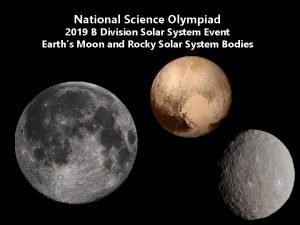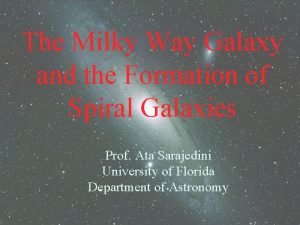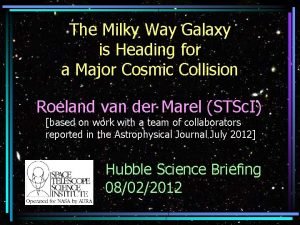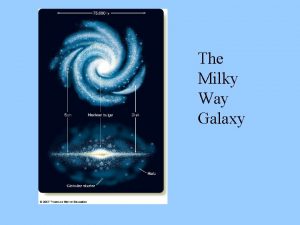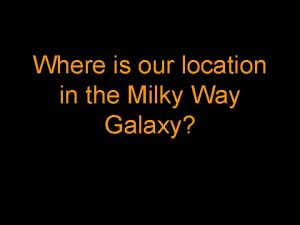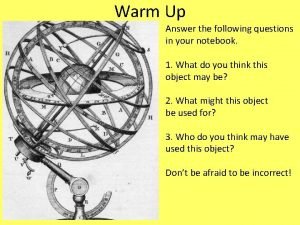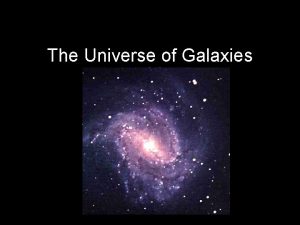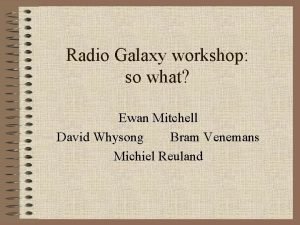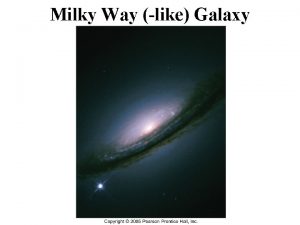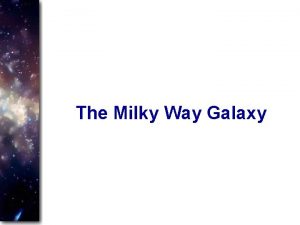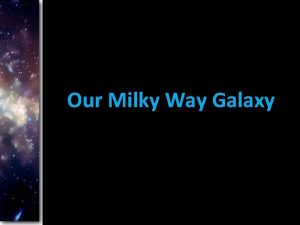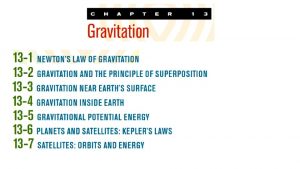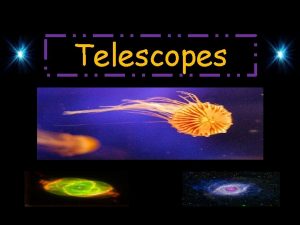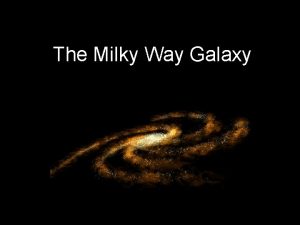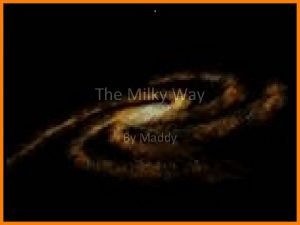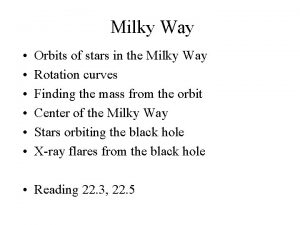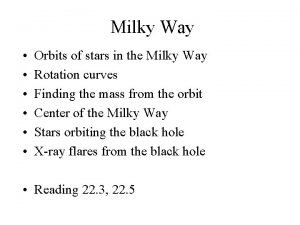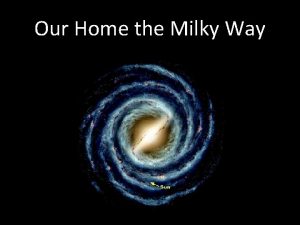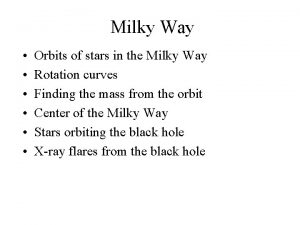The Milky Way Galaxy is Heading for a






























- Slides: 30

The Milky Way Galaxy is Heading for a Major Cosmic Collision Roeland van der Marel (STSc. I) [based on work with a team of collaborators reported in the Astrophysical Journal July 2012] Hubble Science Briefing 08/02/2012

Milky Way Galaxy • Home of our Sun • Flat disk galaxy with spiral structure • Appears to us as a luminous band across the sky 2

Andromeda Galaxy (M 31) • • • Nearest big galaxy to Milky Way 2. 5 million light years away Similar to Milky Way (shape, size, mass) One of few galaxies that can be seen with naked eye First described by astronomers >1000 years ago 3

Local Group R. Powell • The collection of nearby galaxies – region is 3 million lightyears across – bound together by gravity – dominated by Milky Way and Andromeda 4

Triangulum Galaxy (M 33) • Third biggest galaxy in Local Group • 1/10 th the mass of Milky Way and Andromeda 5

The Doppler Motion of Andromeda • We live in an expanding Universe (Edwin Hubble) • Almost all galaxies are moving away from us – Light is redshifted • In 1912, Andromeda was the first galaxy for which a velocity was measured: it is coming towards us at 250, 000 miles/hour – Light is blueshifted • Measurements made with Doppler effect – Measures only velocity component in our direction – Does not yield complete 3 D velocity 6

• After the Big Bang, the Milky Way and Andromeda started moving apart • Due to their gravitational attraction, they are now falling back together • Will Andromeda hit us, or pass at a distance? • Depends on complete 3 D velocity Andromeda’s Approach 7

Proper Motion • The sideways motion on the sky • Determined by comparing images at different times • Necessary to determine the complete 3 D velocity of an object • “Easy” to measure for stars close to the Sun • Very small and difficult to measure for distant objects • Never measured for Andromeda (tried since 1898) • Now finally measured with Hubble Space Telescope 8

Hubble Space Telescope • Provides unique capabilities for astrometry and proper motions because of location above Earth’s atmosphere – Sharp images – Long-term stability – Ability to detect faint sources 9

Andromeda Target Field * 1 of 3 regions observed * 5 -7 yr separation * probes Andromeda halo 10

Positions can be measured for Objects in Target Field * ~10, 000 Andromeda stars * ~200 distant background galaxies 11

Measurement Technique • Measure shift over time of Andromeda stars relative to distant background galaxies 12

Movie: Zoom-in followed by 30, 000 years of projected motion • http: //hubblesite. org/newscenter/archive/releases/2012/20/video/g/ 13

Movie: Zoom-in followed by 30, 000 years of projected motion • Sequence: – – – – View of the night sky Milky Way, Andromeda and Triangulum indicated Constellations overlaid Zoom in to Andromeda Zoom in to field observed with Hubble Black-and-white image of field as observed in 2002 Illustration of how Andromeda stars move relative to distant background galaxies, extrapolated 30, 000 years into the future 14

Proper Motion Result • On the sky, we measure a small proper motion – – Sophisticated data analysis techniques required About 1/100 th of a Hubble camera pixel shift over 7 years 52 micro-arcsec / year Similar to the velocity which human hair grows, as seen at the distance of the Moon • In physical terms, the sideways velocity of M 31 relative to the Milky Way is consistent with zero, and less than 1/3 rd of the approach velocity Andromeda is coming straight at us! • Incorporates – Correction for how the Sun moves inside the Milky Way – Correction for how the stars move inside Andromeda – Additional information for more indirect methods 15

16

Future Collision and Merging • Computer Calculations – Milky Way, Andromeda and Triangulum galaxies (three most massive Local Group galaxies) – Represented by disk, bulge, and halo components – Each galaxy represented by many individual particles (N-body) – Dark matter included – Known positions, distances, velocities, masses – Newtonian orbit calculation subject to gravitational forces – Underlying physics similar to solar system, e. g. , but with distances (millions of lightyears) and time scales (billions of years) much larger 17

Movie: Direct-hit N-body Calculation • http: //hubblesite. org/newscenter/archive/releases/2012/20/video/j/ 18

Movie: Direct-hit N-body Calculation • Time in bottom right, counted from present (t=0) • Sequence: – Milky Way seen from above; stars rotate around Milky Way center in circular motion – (camera angle rotation) Milky Way seen from the side, showing flattened shape – (camera angle zoom-out) Andromeda and M 33 heading towards Milky Way – (4 billion years) Direct Milky Way – Andromeda collision – Galaxies become distorted – Galaxies slow down and fall back together – (6 billion years) Complete Milky Way – Andromeda merger, forms an elliptical galaxy 19

Galaxy Mergers • Galaxy mergers are known to occur elsewhere in the Universe 20

Elliptical Galaxies • Spiral and Elliptical galaxies are the main galaxy types • Ellipticals can form through mergers of spirals 21

Satellite Accretion • Big galaxies often tear apart and swallow smaller satellite galaxies • We know examples of this in both our own Milky Way and in Andromeda 22

Galaxy Formation • Galaxies form and grow bigger through accretion and merging – Satellite accretion events (unequal masses) are more common – Major mergers (similar masses) transform galaxies more dramatically • The future Milky Way – Andromeda merger is an example of “galaxy formation in action” • What makes this future merger so special, is that it will happen to us! 23

So what’s next for Milky Way, Sun, Earth? June 1, 2012 Media headlines: • The end of the galaxy as we know it? • The Mayans were 4 billion years off • CRASH OF THE TITANS • Milky Way Galaxy Doomed • Cosmic smashup predicted • When worlds collide 24

Milky Way Future • The Milky Way will merge with the Andromeda galaxy to become an elliptical galaxy – Their collision does not need to be as direct a hit as shown in the movie – They do always approach each other close enough to make a merger inevitable • Triangulum will become a satellite orbiting the merger remnant – It may even hit the Milky Way first (9% probability) … – … or it could escape from the Local Group (7% probability) 25

Sun Future • Sun will move to larger distance on a more elliptical orbit • Sun may find itself moving through M 33 in next 10 Gyr (20% probability) 26

Earth Future • Sun will still be normal star when Andromeda arrives – But Earth will be too hot for life as we know it • Likelihood that other stars will collide with or pass close to the Sun is small – Vast distances between stars in galaxies – Earth orbit likely to remain unperturbed • Sun will run out of fuel in 6 billion years and become red giant, then white dwarf – Earth will likely be vaporized 27

Movie: Changes to the Night Sky • http: //hubblesite. org/newscenter/archive/releases/2012/20/video/e/ 28

Movie: Changes to the Night Sky • Time in top right, counted from present (t=0) • Sequence: – View of the current night sky – Andromeda approaches and appears bigger on the sky – Milky Way becomes distorted, when Andromeda gets close enough – Bright new regions of star formation appear, as gets compressed by the collision – Star formation ceases, as gas and dust are expelled – An elliptical light concentration remains on the night sky, having replaced today’s familiar Milky Way 29

Conclusions • Today Andromeda is a small fuzzy object in the night sky, first noticed 1000 years ago • After a century of detailed study and technological progress, we now know that 4 billion years from now this galaxy will come to engulf and enshroud our Sun and Earth • This will dramatically change our local Universe, and will take us on an exciting journey through new unexplored territory 30
 Classification
Classification Milky way galaxy shape
Milky way galaxy shape Science olympiad solar system
Science olympiad solar system Canis major dwarf galaxy
Canis major dwarf galaxy Milky way galaxy sketch
Milky way galaxy sketch Democritus milky way
Democritus milky way Myfonterra
Myfonterra Dung beetle milky way
Dung beetle milky way Milky way description
Milky way description What is the name
What is the name Where is the solar system located in the milky way
Where is the solar system located in the milky way The milky way
The milky way Milky appearance of plasma
Milky appearance of plasma Milky ribbon worm
Milky ribbon worm 3 chemical properties of oxygen
3 chemical properties of oxygen Zjezd
Zjezd Perbedaan one way anova dan two way anova
Perbedaan one way anova dan two way anova The old way and the new way
The old way and the new way How to do a two way frequency table
How to do a two way frequency table Anova hypothesis examples
Anova hypothesis examples One was a ship
One was a ship Perbedaan one way dan two way anova
Perbedaan one way dan two way anova One way anova vs two way anova
One way anova vs two way anova Walk this way talk this way
Walk this way talk this way What is threaded binary tree
What is threaded binary tree Uji two way anova
Uji two way anova Project wingman galaxy cbt
Project wingman galaxy cbt Radio galaxy
Radio galaxy John elert galaxy
John elert galaxy Galaxy classification
Galaxy classification Good morning galaxy
Good morning galaxy


